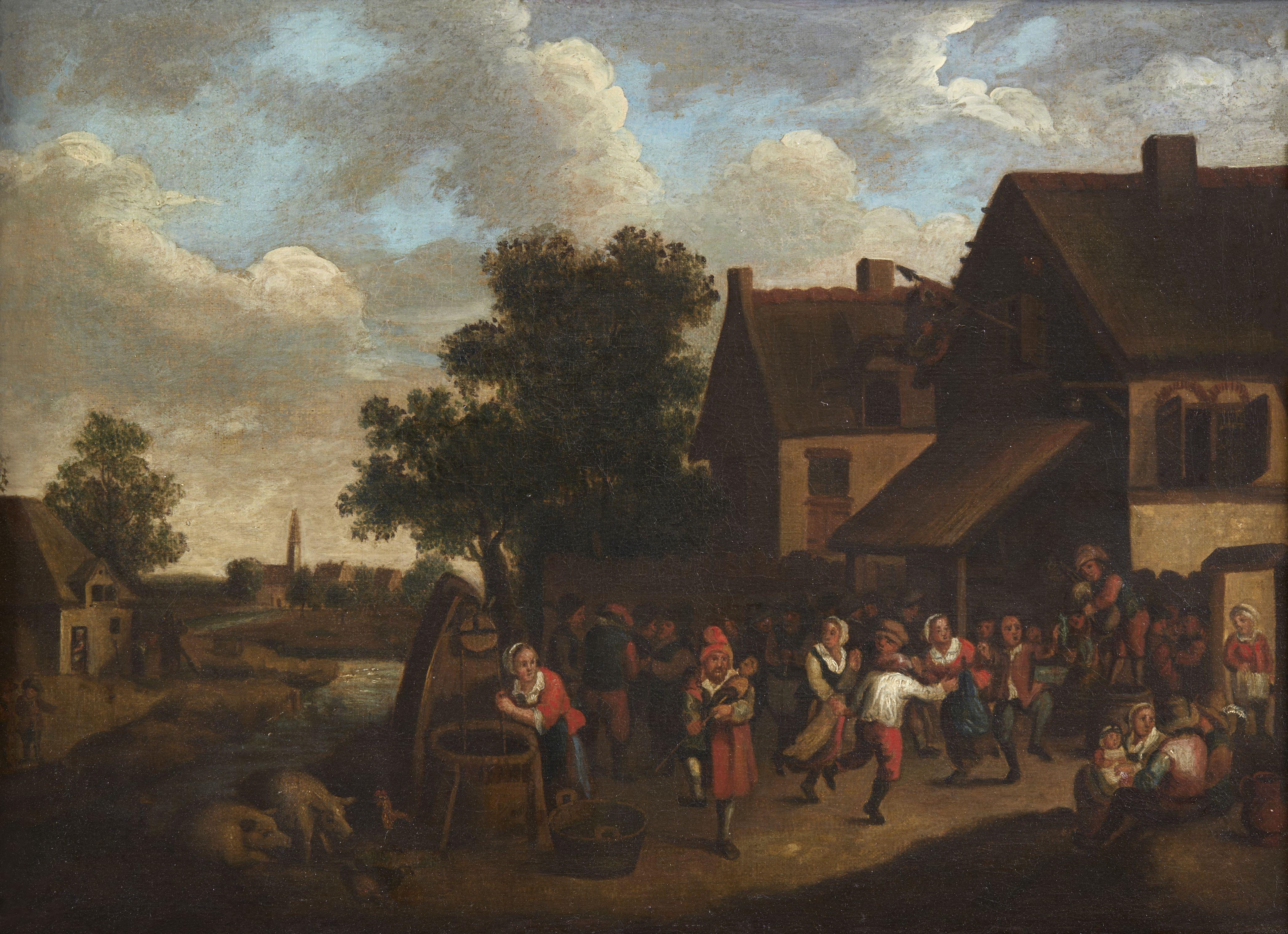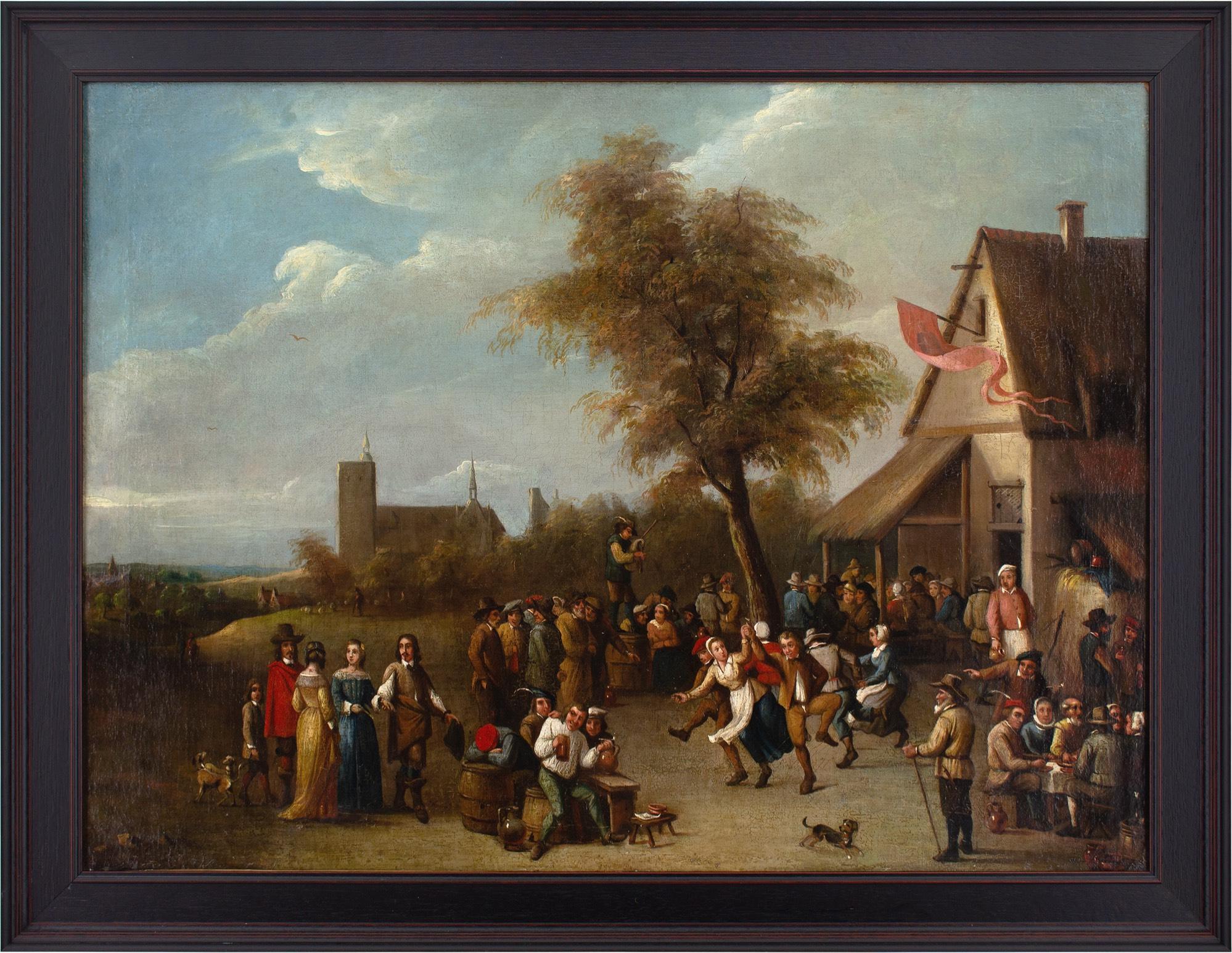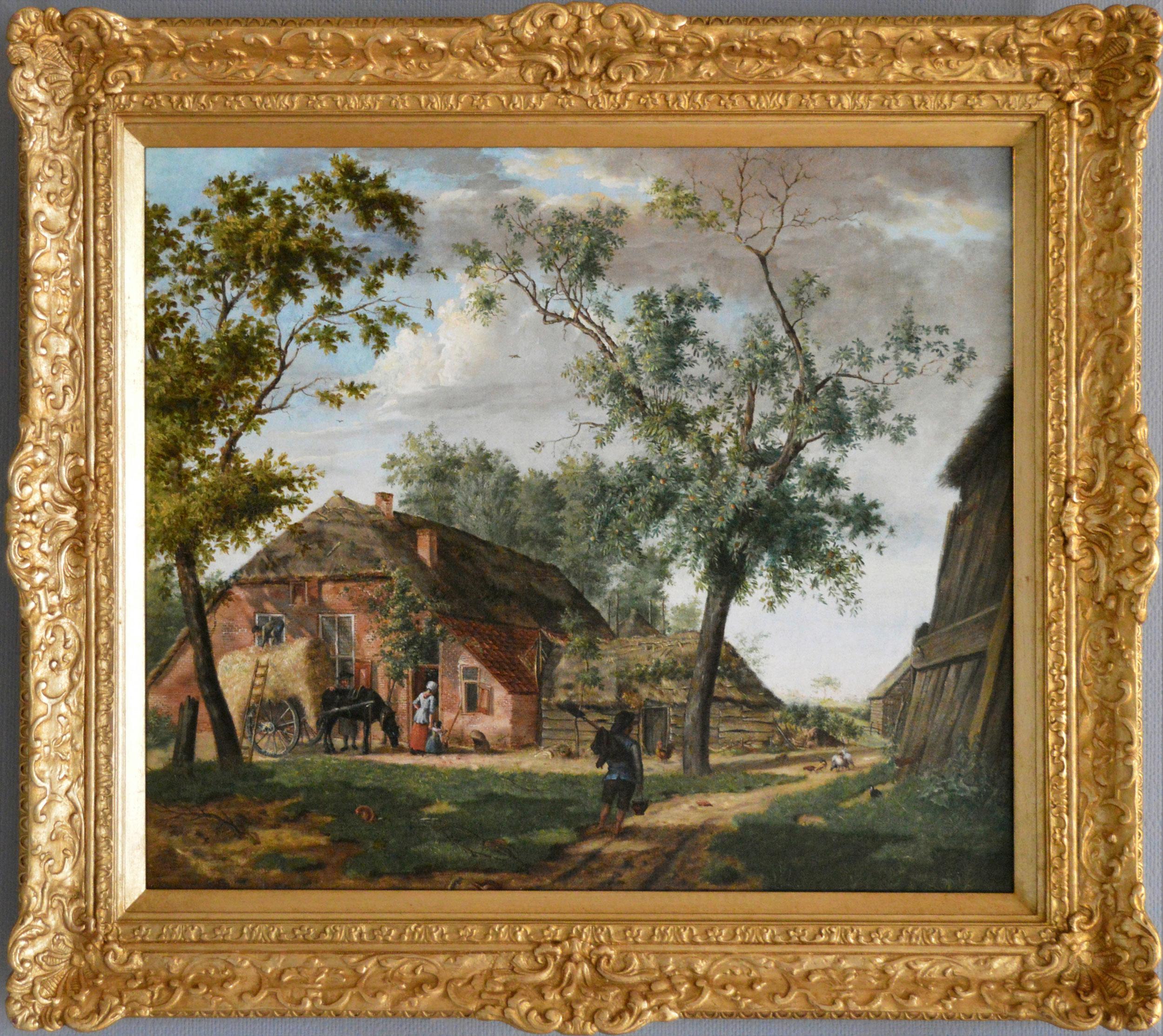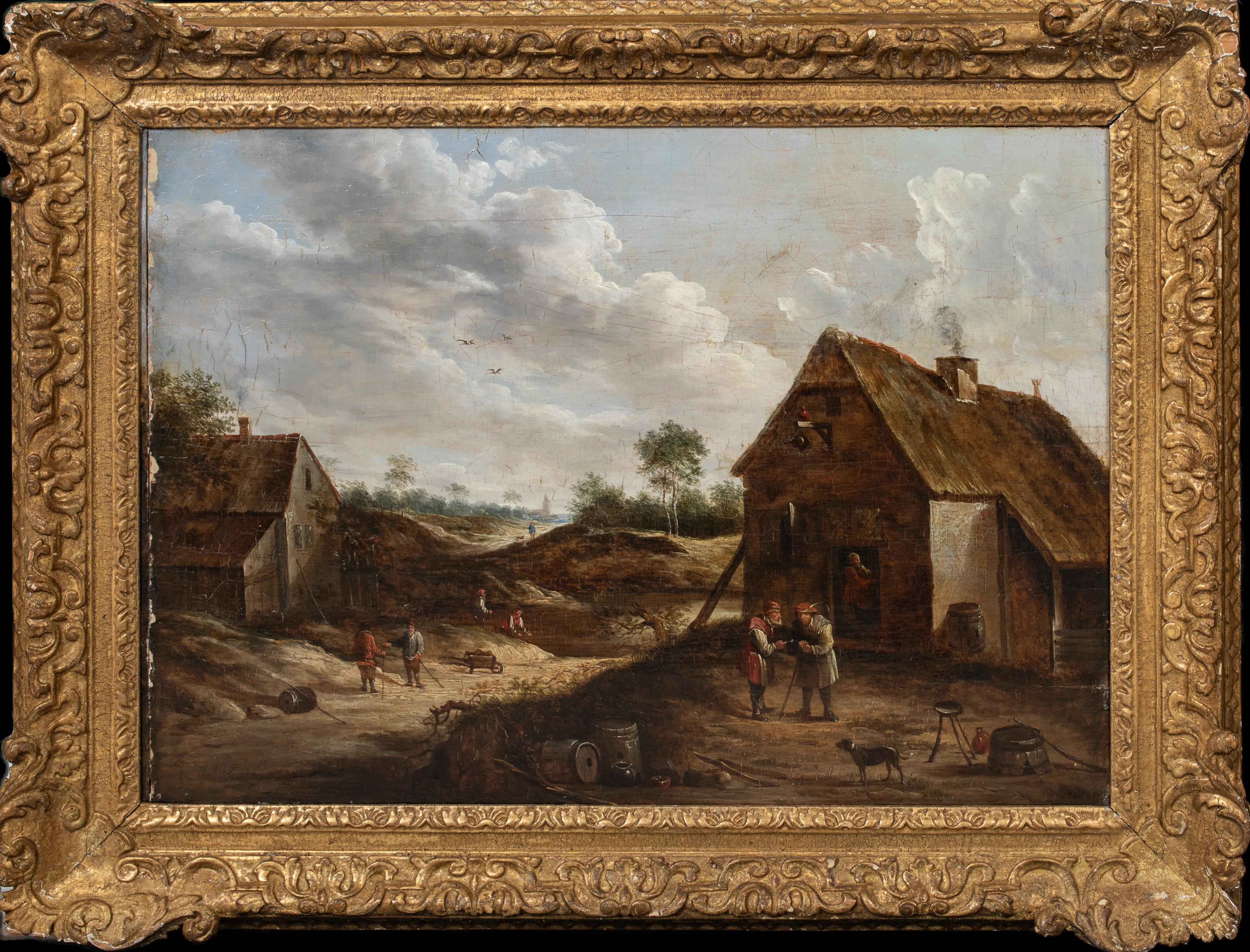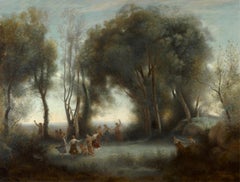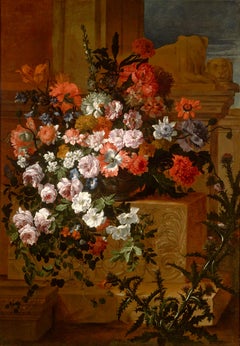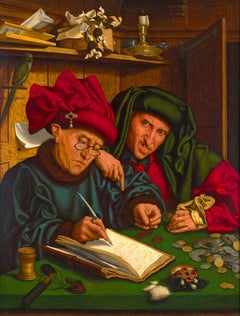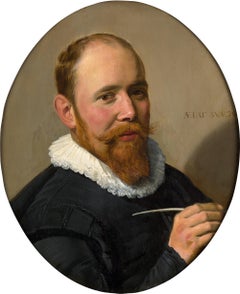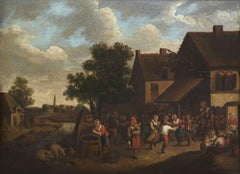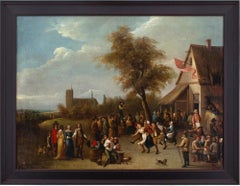Items Similar to A Peasant Country Scene by Jan Thomas van Kessel
Want more images or videos?
Request additional images or videos from the seller
1 of 8
Jan Thomas van KesselA Peasant Country Scene by Jan Thomas van Kessel18th Century
18th Century
$198,000
£149,311.65
€172,686.10
CA$277,792.95
A$308,784.12
CHF 161,858.01
MX$3,771,001.16
NOK 2,020,703.91
SEK 1,901,105.42
DKK 1,288,878.83
About the Item
Jan Thomas van Kessel
1677-1741 Flemish
A Peasant Country Scene
Signed (lower left)
Oil on canvas
A quintessential example of Flemish genre painting, A Peasant Country Scene reflects a blend of the playfulness of subject and the technical acuity that defined the style of 18th-century Flemish painter Jan Thomas van Kessel. The artist invites viewers into a merry gathering of peasants that spills across the composition. Highlighted at its center is a couple in the midst of a lively dance, their direct gaze out at the viewer conveying their happiness, while also serving as an effective means to pull the viewer's eye into the festivities underway.
This gathering of merry revelers assumes a stage-like quality as they are separated visually from the far reaches of the composition by a fence that bisects the composition horizontally, underscoring the intimate feel of the foreground scene. Beyond this enclosure, a farmhouse looms over the scene and opens at right onto a sweeping landscape that carries the eye back into the distant horizon. Here, too, the eye is guided appropriately, as figures dot the path down the river toward the steeple of a church just visible along the horizon line. Overhead, a breathtakingly blue sky, dappled with billowy clouds and soaring birds, complements the festive scene.
Such genre paintings were incredibly popular during the 17th and 18th centuries, as they served as a reminder of the simple pleasures of pastoral life. Such scenes first emerged during the 16th century in the wake of the Reformation as artists sought new fields of painting in which to showcase their skill. Key figures such as David Teniers the Younger and the Brueghel family ensured the genre's success into the 17th century when they became highly fashionable. This enduring popularity thereby afforded later artists like van Kessel the opportunity to showcase their talents in conjuring such engaging vignettes.
Van Kessel clearly capitalized on that popularity, as he developed a following for his works that served as a visual escape from the realities of city life. Little is known of van Kessel's life, save for that he was born in Flanders in 1677 and studied both with the masters of Antwerp's Guild of Saint Luke, and even purportedly trained in Paris. Van Kessel then established his studio in his hometown of Antwerp just after the dawn of the 18th century. Aiding in van Kessel's rapid development as an artist was undoubtedly the fact that he descended from a long family line of painters who explored various subjects from botanical studies to portraits. It is arguably van Kessel's inviting scenes of peasants and pastoral life, as seen in this composition, however, that are the most engaging of his family's oeuvre and earned the artist acclaim for his work in Antwerp and beyond.
One point often noted in van Kessel's genre paintings are the references he makes to past masters like Teniers, and these connections are tangible in this painting. The layout of this composition, from the cluster of animated figures in the foreground contrasted against the serene expanse of nature in the distance, seem to be direct quotations of Teniers' work. This reinforces both the placement of this work within the 18th century – following Teniers' lifetime – and within van Kessel's body of work. The connection of this painting to Jan Thomas van Kessel's oeuvre is without dispute, however, as this painting benefits from the scrolling script of the artist's signature along the lower edge.
Only a handful of van Kessel's works, including those held by prestigious collections such as England's National Trust and the Museum Catharijneconvent in the Netherlands, have been fully documented. As a result, it is rare when such a well-preserved example of this 18th-century Flemish genre painting tradition emerges, and it is particularly exciting when such a find contributes to the emerging legacy of a little-understood artist of the era.
Canvas: 40 1/4" high x 54 1/4" wide
Frame: 52 3/4" high x 66 5/8" wide
- Creator:Jan Thomas van Kessel (1677 - 1741, Flemish)
- Creation Year:18th Century
- Dimensions:Height: 52.75 in (133.99 cm)Width: 66.63 in (169.25 cm)Depth: 3 in (7.62 cm)
- Medium:
- Movement & Style:
- Period:
- Condition:
- Gallery Location:New Orleans, LA
- Reference Number:Seller: 31-01981stDibs: LU18615260042
About the Seller
5.0
Vetted Professional Seller
Every seller passes strict standards for authenticity and reliability
Established in 1912
1stDibs seller since 2013
18 sales on 1stDibs
Typical response time: 10 hours
- ShippingRetrieving quote...Shipping from: New Orleans, LA
- Return Policy
Authenticity Guarantee
In the unlikely event there’s an issue with an item’s authenticity, contact us within 1 year for a full refund. DetailsMoney-Back Guarantee
If your item is not as described, is damaged in transit, or does not arrive, contact us within 7 days for a full refund. Details24-Hour Cancellation
You have a 24-hour grace period in which to reconsider your purchase, with no questions asked.Vetted Professional Sellers
Our world-class sellers must adhere to strict standards for service and quality, maintaining the integrity of our listings.Price-Match Guarantee
If you find that a seller listed the same item for a lower price elsewhere, we’ll match it.Trusted Global Delivery
Our best-in-class carrier network provides specialized shipping options worldwide, including custom delivery.More From This Seller
View AllDance of the Nymphs
By Paul Desire Trouillebert
Located in New Orleans, LA
This lyrical landscape entitled Dance of the Nymphs was composed by the French Barbizon painter Paul Désiré Trouillebert. A joyful scene of nymphs dancing the morning fog, the work closely resembles an important work by the great Camille Corot, which is now housed at the Musée d'Orsay (Paris). Renowned for his unique individuality that toed the line between the traditional and modern, Corot and his landscapes helped pave the way for an entire generation of Impressionists who followed him. Trouillebert perfectly captures the poetic atmosphere of Corot’s groundbreaking works, while also imbuing this scene with a freshness and character that is all his own.
Trouillebert's oil on canvas is exemplary of the tradition of historical painting. The work perfectly combines a realistic depiction of the natural world with a spirited romanticism as his idealized nymph figures frolic playfully beneath a crisp morning sky. As a whole, it is a lovely composition executed with a level of skill and artistry that proves Trouillebert's exceptional talent in the arts.
Born in Paris in 1831, Paul Désiré Trouillebert was a student of the academic painters Ernest Hébert...
Category
19th Century Academic Landscape Paintings
Materials
Canvas, Oil
Still Life With Flowers By Jean-Baptiste Monnoyer
By Jean-Baptiste Monnoyer
Located in New Orleans, LA
Jean-Baptiste Monnoyer
1636-1699 French
Still Life with Flowers on a Carved Stone Ledge
Oil on canvas
Impeccable detail and luminous color breathe life into this floral still lif...
Category
17th Century Old Masters Still-life Paintings
Materials
Canvas, Oil
Price Upon Request
The Tax Collectors attributed to Marinus van Reymerswaele
Located in New Orleans, LA
Marinus van Reymerswaele
c.1490 – c.1546 Dutch
The Tax Collectors
16th century
Oil on wood panel
Marinus van Reymerswaele stands among the greatest and most beloved artists of 16th-century Antwerp. Entitled The Tax Collectors, this oil on board original exudes the technical skill and life-like vibrancy for which the artist is renowned.
In a quiet interior scene, two men sit at a green table covered in coins, jewels, and empty moneybags. While the man in the red turban...
Category
16th Century Figurative Paintings
Materials
Oil, Wood Panel
Portrait Of A Gentleman By Frans Hals
Located in New Orleans, LA
Frans Hals
1582-1666 Dutch
Portrait of a Gentleman
(possibly Theodore Blevet)
Oil on panel
“Frans Hals is a colourist among the colourists...Frans Hals must have had twenty-seven blacks...
Category
17th Century Old Masters Portrait Paintings
Materials
Oil, Panel
Price Upon Request
Across the River by Sir David Murray
By Sir David Murray
Located in New Orleans, LA
Sir David Murray, R.A., H.R.S.A., R.S.W., R.I.
1849-1933 • Scottish
Across the River
Signed and dated D. Murray 1907 (lower left)
Signed and inscribed “Across the River/by David M...
Category
Early 20th Century Academic Landscape Paintings
Materials
Canvas, Oil
Jan Cornelis Sylvius, Preacher by Rembrandt Van Rijn
By Rembrandt van Rijn
Located in New Orleans, LA
Rembrandt van Rijn
1606–1669 Dutch
Jan Cornelis Sylvius, Preacher
New Hollstein Dutch and Flemish (Rembrandt) 235, state 2/2
Bartsch 280
Printed by Rembrandt
Signed and dated "Rem...
Category
17th Century Old Masters Portrait Drawings and Watercolors
Materials
Paper, Etching
You May Also Like
18th Century Landscape Flemish Scool Outdoor Peasant Oil on Canvas Brown Blue
Located in Sanremo, IT
Painting oil on canvas measuring 45 x 55 cm without frame and 65 x 75 cm with frame depicting an outdoor peasant scene from the Flemish school of the late 17th and early 18th centur...
Category
1690s Flemish School Landscape Paintings
Materials
Canvas, Oil
Villagers in a Landscape - Flemish 17thC art figurative landscape oil painting
Located in Hagley, England
This fantastic Flemish 17th century Old Master oil painting is by Thomas Van Apshoven. It was painted circa 1650 and depicts a village with figures outside a tavern, eating, drinking and dancing. Beyond are more dwellings, villagers and animals, all under a blue summer's sky. The detail, brushwork and vibrant colouring are superb. This is an excellent example of Apshoven's work and a typical subject he loved to paint.
Provenance. Leominster estate.
Wax stamp verso.
Condition. Oil on panel, 22 inches by 17 inches and in good condition.
Frame. Housed In beautiful gilt frame, 30 inches by 25 inches and in good condition.
Thomas van Apshoven (1622– 1664) was a Flemish painter known for his landscapes with peasant scenes and genre scenes in interiors. His genre scenes depict village festivals, the interiors of taverns, village scenes or landscapes with peasants engaged in various activities, singeries, guardroom scenes and laboratories of alchemists. Some still lifes have also been attributed to him. His themes and style are close to that of David Teniers the Younger. He was born on 30 November 1622 in Antwerp as the eldest son of Ferdinand van Apshoven the Elder and Leonora Wijns. His father was a painter who had studied with Adam van Noort and had become a master of the Antwerp Guild of Saint Luke in 1596. No paintings by his father are known. His younger brother Ferdinand van Apshoven the Younger became also a successful painter. Thomas studied under his father. Some sources state that he became a pupil of the prominent genre painter David Teniers the Younger. It is more likely, however, that he was an imitator of Teniers. He was registered as a 'wijnmeester' [son of a master] in the Guild of St. Luke of Antwerp in the guild year 1645–1646. He married Barbara Janssens on 22 March 1645. The couple had four children. The godfathers of the children included the painters Victor Wolfvoet...
Category
1650s Old Masters Figurative Paintings
Materials
Oil
Circle of David Teniers, Landscape with Peasants by an Inn and a River, Dutch
By David Teniers the Younger
Located in Greven, DE
Circle of Teniers, Peasants in a Landscape passing by a river and an Inn.
Category
17th Century Baroque Figurative Paintings
Materials
Oil, Panel
$3,578 Sale Price
25% Off
David Teniers The Younger (After), Country Celebration
By David Teniers the Younger
Located in Cheltenham, GB
This charming mid-18th-century oil painting depicts a veritable array of revellers holding a feast by a tavern. It’s after a work by Flemish artist, David Teniers the Younger (1610-1...
Category
1750s Figurative Paintings
Materials
Oil, Canvas
Early 19th Century landscape oil painting of a farm
By Hermanus van Brussel
Located in Nr Broadway, Worcestershire
Hermanus van Brussel
Dutch, (1763-1815)
The Farmyard
Oil on canvas
Image size: 18.25 inches x 21.25 inches
Size including frame: 24.5 inches x 27.5 inches
Provenance: Frost & Reed
A...
Category
Early 19th Century Landscape Paintings
Materials
Canvas, Oil
Peasants Villagers Talking, 17th Century Pieter de Molijn (1595-1661)
Located in Blackwater, GB
Peasants Villagers Talking, 17th Century
Pieter de Molijn (1595-1661) to $120,000
Large 17th Century Dutch Old Master of peasant villagers in conversation, oil on panel. Excellent ...
Category
17th Century Landscape Paintings
Materials
Oil, Panel
$5,518 Sale Price
20% Off
More Ways To Browse
Old Antique Keys
Thomas Downing Artist
Old Master Birds
18th Century Bird Painting
New England Church Painting
Flemish Scroll
Flemish 18th Century Oil Painting
Used Church Steeples
Flemish 16th Century Painting
Church Steeple
Bird Oil Painting 18th Century
David Spiller Art
Jans Van Kessel
Artist Marjorie
Forest Floor Paintings
Northwest Coast
Painting Boats On A Lake
David Ford
